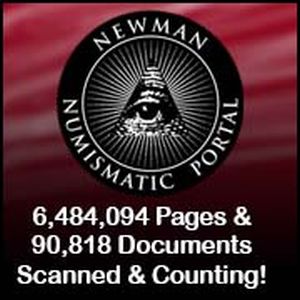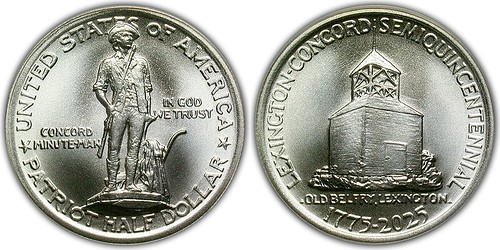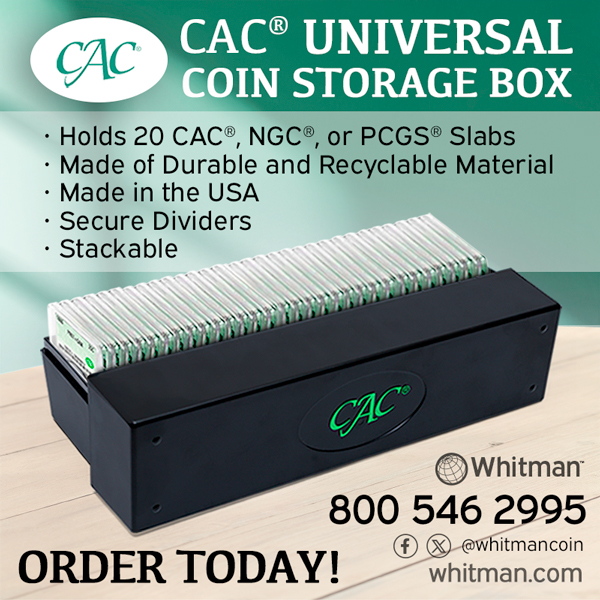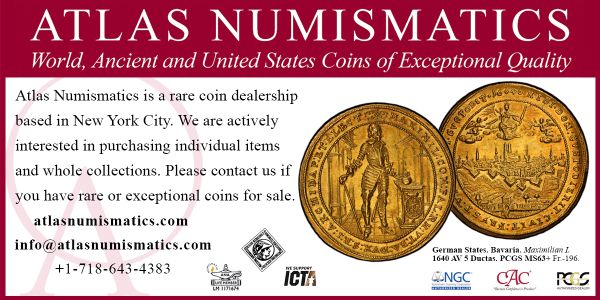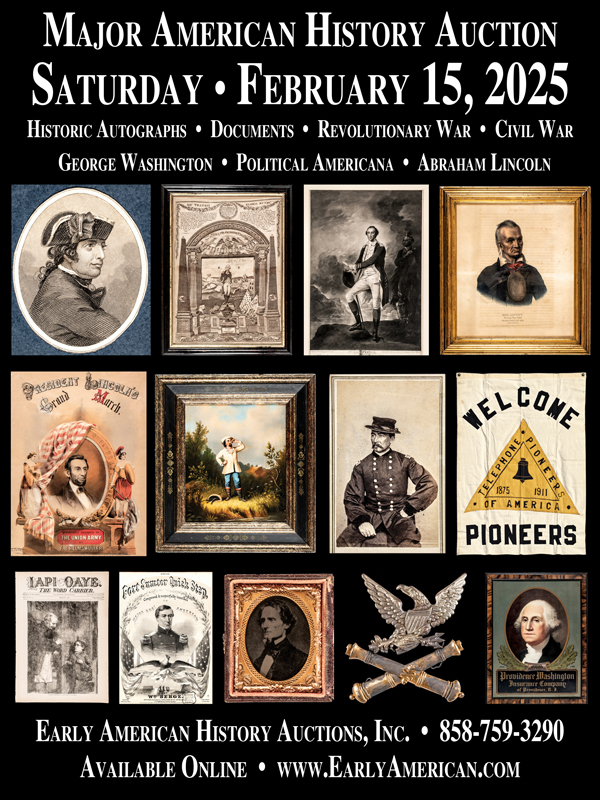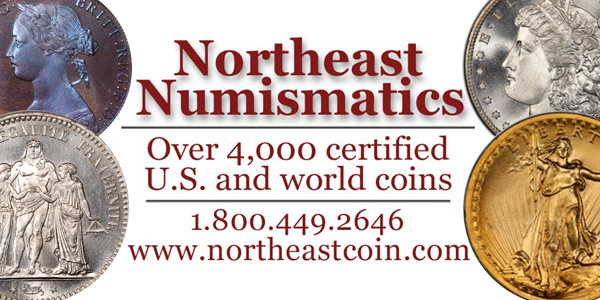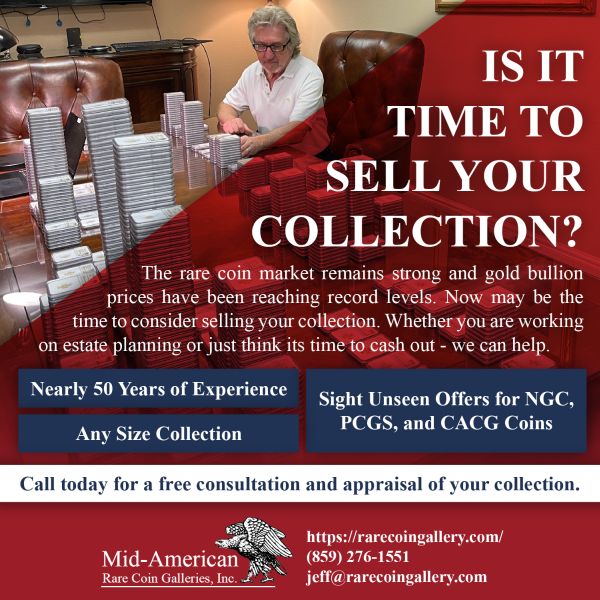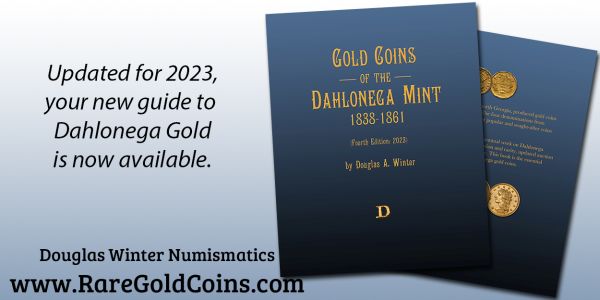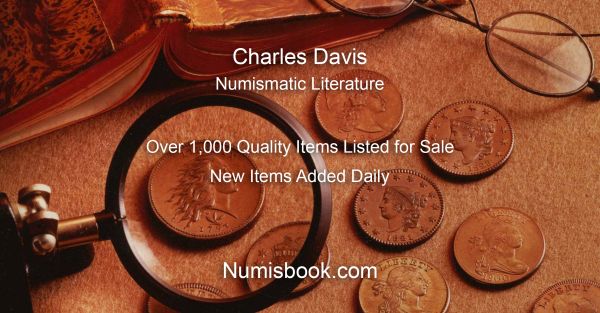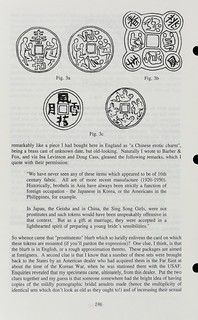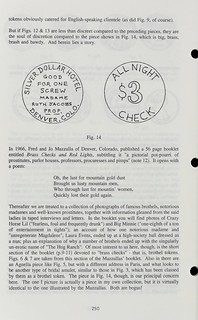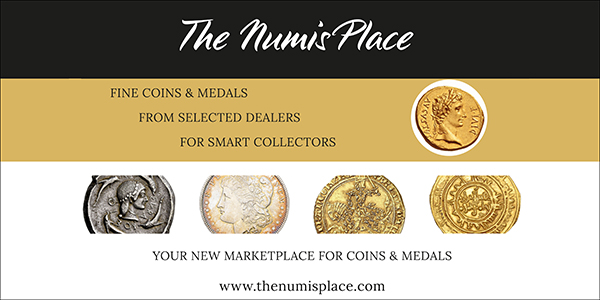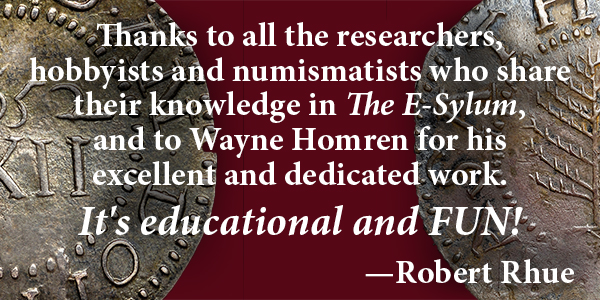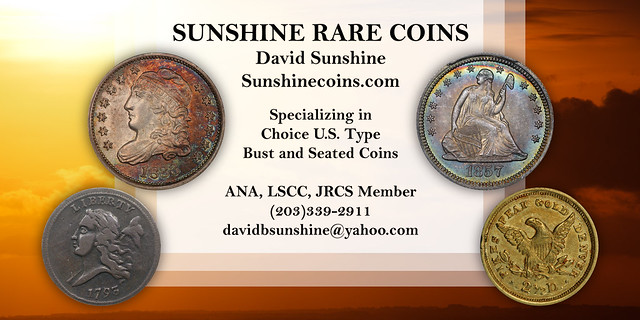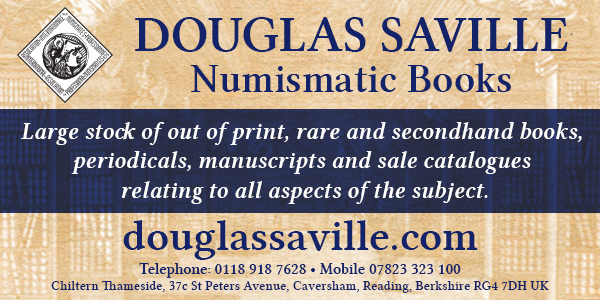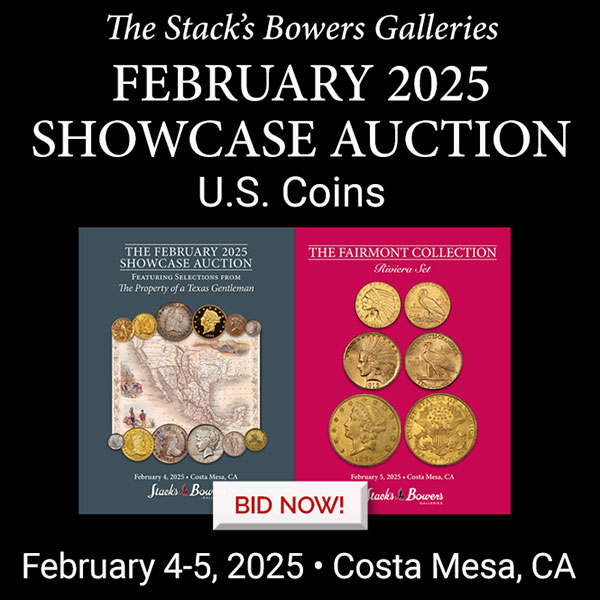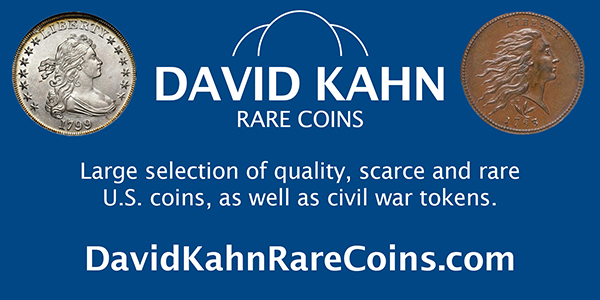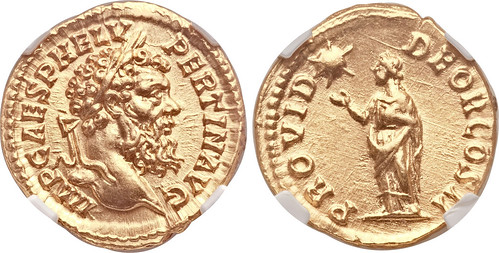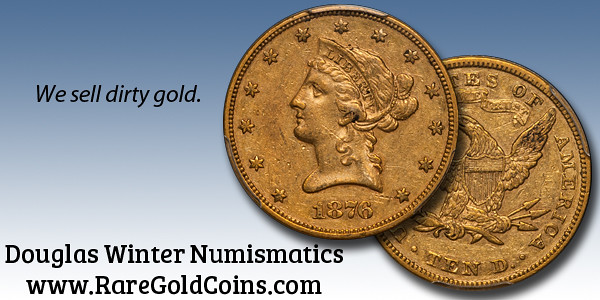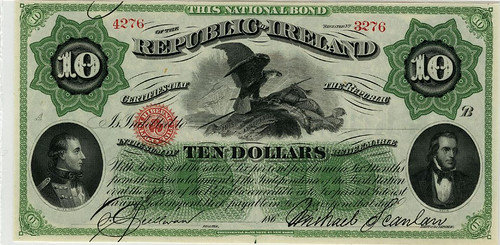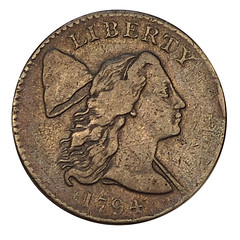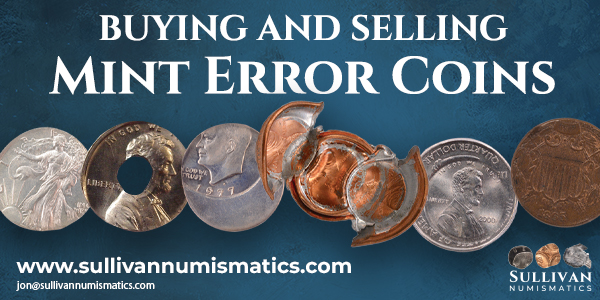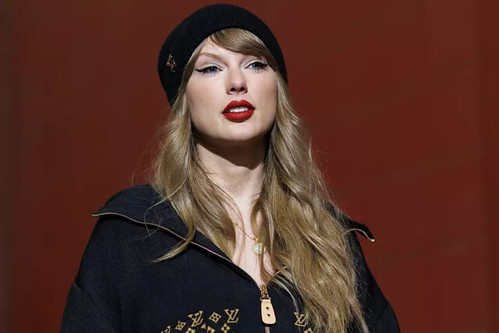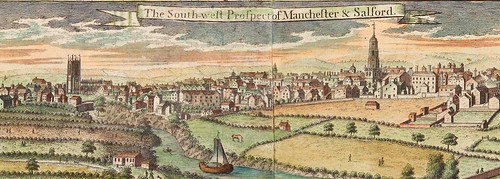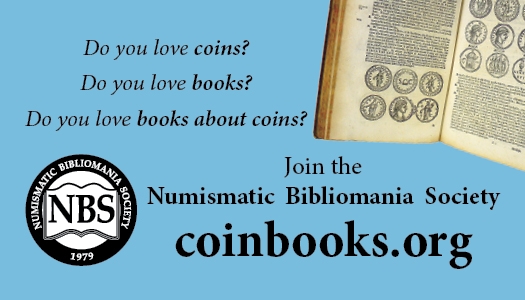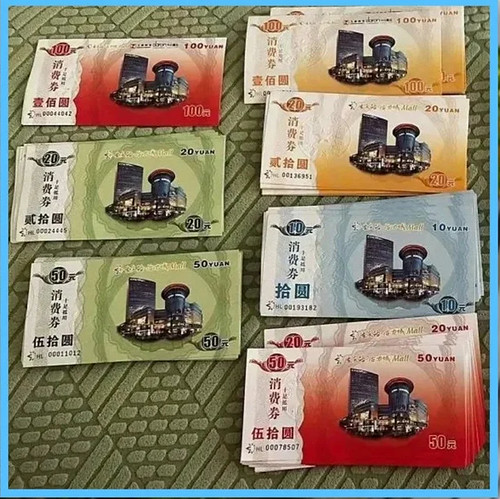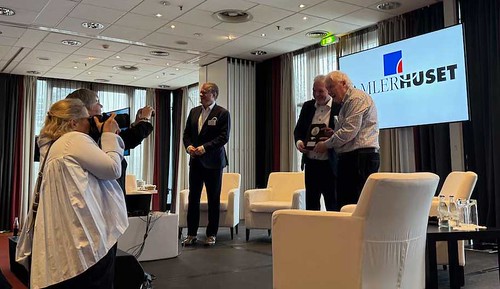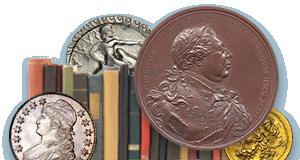
Visit our NBS Sponsors


About UsThe Numismatic Bibliomania Society is a non-profit association devoted to the study and enjoyment of numismatic literature. For more information please see our web site at coinbooks.org SubscriptionsThose wishing to become new E-Sylum subscribers (or wishing to Unsubscribe) can go to the following web page link MembershipThere is a membership application available on the web site Membership Application To join, print the application and return it with your check to the address printed on the application. Print/Digital membership is $40 to addresses in the U.S., and $60 elsewhere. A digital-only membership is available for $25. For those without web access, write to: Jeff Dickerson, Treasurer AsylumFor Asylum mailing address changes and other membership questions, contact Jeff at this email address: treasurer@coinbooks.org SubmissionsTo submit items for publication in The E-Sylum, write to the Editor at this address: whomren@gmail.com BUY THE BOOK BEFORE THE COINSale CalendarWatch here for updates! |
- WAYNE'S WORDS: THE E-SYLUM FEBRUARY 2, 2025
- BENJAMIN WEST BRITISH COIN LETTER OFFERED
- NEW BOOK: MONEY, COINAGE AND COLONIALISM
- NEW BOOK: GELD AUS DEM NORDEN
- NEW BOOK: INDIAN COINAGE 10TH EDITION
- VALE MERRILL GIBSON (1952-2024)
- DAVID MICHAEL SMOCK (1984-2025)
- NUMISMATICS OF PUNXSUTAWNEY
- VIDEO: CANADIAN DOLLARS: AN INTRODUCTION
- ROMAN COINS OF EGYPT PRESENTATION
- OLDEST COINS FOUND IN CHANGE
- NOTES FROM E-SYLUM READERS: FEBRUARY 2, 2025
- 2025 LEXINGTON-CONCORD COMMEMORATIVE
- THE TOMB OF WILLIAM STRICKLAND
- GIRL SCOUTS USA DAISY DOLLARS
- VOCABULARY TERM: REEDED EDGE, REEDING
- THE ALAN KESSLER MYSTERY
- 2025 ANS TRUSTEES' AWARD TO THE NYINC
- GERRY FORTIN INTERVIEW, PART FIVE
- CNG TRITON XXVIII AUCTION RESULTS
- ATLAS NUMISMATICS SELECTIONS: FEBRUARY 2, 2025
- ARCHIVES INTERNATIONAL AUCTION 99 SELECTIONS
- NUMISMATIC AUCTIONS LLC SALE 69
- TAYLOR SWIFT'S ANCIENT COIN NECKLACE
- 1793 MANCHESTER PROMISSORY HALFPENNY, PART TWO
- COLLECTABLE COUNTERFEIT COINS, PART TWO
- IRAN CONSIDERING CURRENCY REVALUATION
- NORTH KOREAN REVALUATION RUMORED
- CHINESE COMPANY PAYS EMPLOYEES IN SCRIP
- LOOSE CHANGE: FEBRUARY 2, 2025
- FEATURED WEBSITE: THE PAPER MONEY PROJECT
- ABOUT THIS ISSUE: FEBRUARY 2, 2025
Content presented in The E-Sylum is not necessarily researched or independently fact-checked, and views expressed do not necessarily represent those of the Numismatic Bibliomania Society.
WAYNE'S WORDS: THE E-SYLUM FEBRUARY 2, 2025
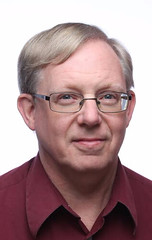 New subscribers this week include:
Larry Hanks, courtesy of Bob Steinberg;
Daniel Salinero of Indio, California; and
Mike Byers.
Welcome aboard! We now have 7,254 subscribers.
New subscribers this week include:
Larry Hanks, courtesy of Bob Steinberg;
Daniel Salinero of Indio, California; and
Mike Byers.
Welcome aboard! We now have 7,254 subscribers.
Thank you for reading The E-Sylum. If you enjoy it, please send me the email addresses of friends you think may enjoy it as well and I'll send them a subscription. Contact me at whomren@gmail.com anytime regarding your subscription, or questions, comments or suggestions about our content.
This week we open with an interesting 1798 letter from American artist Benjamin West, three new books, two obituaries, updates from the Newman Numismatic Portal, notes from readers, and more.
Other topics this week include Indian coinage, Canadian dollars, the Roman coins of Egypt, old coins found in change, an unofficial semiquincentennial half dollar, Daisy Dollars, fixed price and auction highlights, Taylor Swift's ancient coin necklace, currency revaluations, and The Paper Money Project.
To learn more about coinage and colonialism, the primitive money of Myanmar, the National Bank Notes of Punxsutawney, PA., the tomb of William Strickland, reeded edges, knurls and flutes, Alan Kessler, the Fenian Brotherhood, Manfred Dunker, and the Numerology Masonic Prophetic Magic Square Knights Templar Themed Medal, read on. Have a great week, everyone!
Wayne Homren
Editor, The E-Sylum
BENJAMIN WEST BRITISH COIN LETTER OFFERED
The William Reese Company is offering an interesting 1798 letter from American artist Benjamin West about his drawings for British coin designs. Mitch Fraas alerted us to this item back in December 2021. It's still available; I came across it again this week and thought we should have another look at it. -Editor
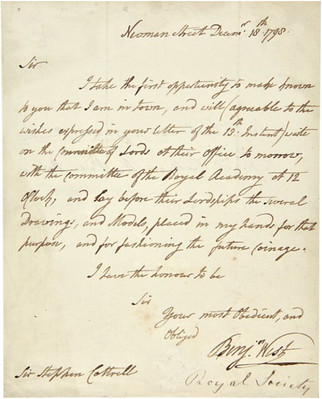 An interesting letter from the great American-born artist, Benjamin West, regarding drawings and models created for British coins. Benjamin West (1738-1820) was born in Springfield, Pennsylvania, and studied art in America and Italy before moving to England permanently in 1763. West was a founder of the Royal Academy and its second president (following Sir Joshua Reynolds, and serving in that capacity from 1792 until his death), became "History Painter to the King" in 1772, and was commissioned by George III to execute some sixty paintings between 1768 and 1801. The text of the letter reads:
An interesting letter from the great American-born artist, Benjamin West, regarding drawings and models created for British coins. Benjamin West (1738-1820) was born in Springfield, Pennsylvania, and studied art in America and Italy before moving to England permanently in 1763. West was a founder of the Royal Academy and its second president (following Sir Joshua Reynolds, and serving in that capacity from 1792 until his death), became "History Painter to the King" in 1772, and was commissioned by George III to execute some sixty paintings between 1768 and 1801. The text of the letter reads:
"Sir, I take the first opportunity to make known to you that I am in town, and will (agreeable to the wishes expressed in your letter of the 13th instant) wait on the committee of Lords at their office tomorrow, with the committee of the Royal Academy at 12 o'clock, and lay before their Lordships the several drawings, and models, placed in my hands for that purpose, and for fashioning the future coinage. I have the honour to be, sir, your most obedient, and obliged Benj. West."
NEW BOOK: MONEY, COINAGE AND COLONIALISM
Nanouschka Myrberg Burström and Fleur Kemmers has written a new book on how money affected the relations between colonizer and colonized, published by Routledge. Here's some information and sample pages. -Garrett
Money, Coinage and Colonialism
Nanouschka Myrberg Burström (Editor)
Fleur Kemmers (Editor)
Routledge (Publisher)
Description
 This book explores coinage and related object types as an important form of material culture that is crucial to interrogating interactions between coloniser and colonised.
This book explores coinage and related object types as an important form of material culture that is crucial to interrogating interactions between coloniser and colonised.
Money, Coinage and Colonialism is a much overdue treatment of coinage and money in debates around ancient and recent colonial practices. It argues that coinage offers unique opportunities to study interactions and effects of the meeting between colonisers and colonised, as well as the economic, political and ideological interactions between colonial communities and the state of origin. It is argued that the study of coins and other means of exchange may reveal less apparent and under-communicated processes, values and discourses in the study of colonial environments and projects, with commonalities informing a larger "global history" approach. A broad picture is built from numerous case studies, spanning from Classical Greek colonies to European colonial enterprises of the Modern period, exploring colonial histories, settings, ideology and resistance. Particular attention is paid to the role of coins in identity construction; to ambiguity, hybridity and creolisation of monetary objects in colonial contexts; and to specific uses of coins that tell of violence, oppression and resistance as well as of networks, acculturation and globalisation.
NEW BOOK: GELD AUS DEM NORDEN
The January 2025 International Primitive Money Society Newsletter had a short article about a new book on the primitive money of Myanmar, north Thailand and Laos. With permission we're republishing it here. Images courtesy Editor Bob Leonard. Thank you. -Editor
 Hans Menzel-Severing has self-published a fine study of
the primitive money of Myanmar, north Thailand and
Laos (Shan states and Lannatai), Geld aus dem Norden,
(hardbound, 209 p., illustrated in color throughout,
German text [easy to follow], 2024), apparently based on
his own outstanding collection. No price stated and not
available from the usual U.S. sources, but he will be glad
to quote price and shipping.
Hans Menzel-Severing has self-published a fine study of
the primitive money of Myanmar, north Thailand and
Laos (Shan states and Lannatai), Geld aus dem Norden,
(hardbound, 209 p., illustrated in color throughout,
German text [easy to follow], 2024), apparently based on
his own outstanding collection. No price stated and not
available from the usual U.S. sources, but he will be glad
to quote price and shipping.
This study covers various forms of circular silver ingots (flower money, toks, pig-mouths, and leaf-money) plus an exhaustive catalog of cigar- shaped ingots. Ten pages are devoted to the so-called leech-money of Luang Prabang, 1353-1571 (?), with its stamps.
Other forms of bar money, such as "Fish-Money" and tiger tongues follow. Next is a section on Ka-K'im and bracelet coins, Chiengsaen bars, and trade dollars (including chopmarks). The frontispiece is a map of related sites.
NEW BOOK: INDIAN COINAGE 10TH EDITION
A new edition of the Indian coinage book by Sainath Reddappa has been published. Also found via the Winter 2024 issue of the Journal of the Oriental Numismatic Society. Here's information from the publisher's website. -Editor
 Indian Coinage 2023-24 British India Portuguese India Republic India (1835-2024) 10th Edition
Indian Coinage 2023-24 British India Portuguese India Republic India (1835-2024) 10th Edition
By Sainath Reddappa
Hard Back/ Full Color/ISBN : 978-93-340-7242-6/ M.R.P ?999.00 / $45
About the book
Indian Coinage British India – Portuguese India – Republic India (1835 – 2024), 10th Edition, is a complete guidebook cum Checklist for Numismatist. This edition is updated up to date and enhanced version of former editions. This book is drafted to be a supporting guide to numismatist in identifying rare coins and its average market value. Keen study has been made by surveying and interacting with various coin sellers and numismatists from different parts of the country.
Book system
This book is classified into three major Parts, British India, Portuguese India & Republic India coins. British India Coins comprises coins issued by the British, during their rule in India between 1835 and 1947. This part illustrates coins of various denominations issued under British Rule. Portuguese India coins comprise of coins issued between 1871 – 1961 (Machine Struck). Republic India comprises of coins issued by the Government of India after India became Republic. This book catalogs Republic India Coins from 1950 to 2024. Republic India coinage is further classified into Commemorative Issue, Uncirculated Sets, Proof Sets, Uncirculated Regular Issue & Proof Set Regular Issue.
VALE MERRILL GIBSON (1952-2024)
The Ancient Coin Club of Los Angeles announced the passing of former President Merrill Gibson. Thanks to Mike Markowitz for sending this along. -Editor
 With great sadness, we report that long time Ancient Coin Club of Los Angeles member Merrill Gibson passed away from cancer on December 21, 2024 - just two months shy of his 72nd birthday.
With great sadness, we report that long time Ancient Coin Club of Los Angeles member Merrill Gibson passed away from cancer on December 21, 2024 - just two months shy of his 72nd birthday.
Merrill was born in Los Alamos, New Mexico (his father worked at the Los Alamos National Laboratory) and was raised there with his sister Dianna. Merrill went on to gain an engineering degree from Cal Tech. He worked in a variety of employments including working as a mortgage broker and designing web pages prior to settling down with Apollo Numismatics.
Merrill joined the Club at the February 11, 2004 meeting and remained active until the end. He served for 16 years on the ACCLA Board of Directors (2006-2021). For two of those years (2013 and 2014) he served as Club President.
DAVID MICHAEL SMOCK (1984-2025)
ANA District Representative, author, and Money Talks presenter David Smock recently passed away. -Garrett
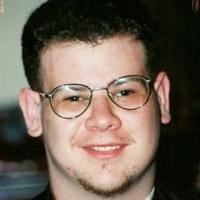 David Michael Smock, 40, of Jonesboro passed away Friday, January 17, 2025, at his home in Jonesboro. Born in 1984 in Jonesboro, David lived a life marked by creativity, determination, and love for those around him. David attended Annandale High School in Annandale, Virginia, where he was an active member of the Student Government Association and graduated at Constitution Hall in Washington, D.C. He went on to study at Arkansas State University-Newport where he continued his involvement in student government. He also attended Lyon College in Batesville. David was deeply engaged in his community and served as a canvasser for Chad Causey during his Arkansas Congressional campaign.
David Michael Smock, 40, of Jonesboro passed away Friday, January 17, 2025, at his home in Jonesboro. Born in 1984 in Jonesboro, David lived a life marked by creativity, determination, and love for those around him. David attended Annandale High School in Annandale, Virginia, where he was an active member of the Student Government Association and graduated at Constitution Hall in Washington, D.C. He went on to study at Arkansas State University-Newport where he continued his involvement in student government. He also attended Lyon College in Batesville. David was deeply engaged in his community and served as a canvasser for Chad Causey during his Arkansas Congressional campaign.
A passionate and award-winning coin collector, David received numerous accolades for his collection and wrote articles for prominent professional publications including Coin World, The Numismatist, and Numismatic News. Beyond his interest in numismatics, David was a talented visual artist, woodcarver, and jewelry maker. He presented two of his medallion pieces to musicians Rosanne Cash and Rodney Crowell the night of their 2023 performance at the Sunken Lands Songwriters Circle concert in A-State's Riceland Hall. David was an avid Elvis Presley fan from the time he was six years old, frequently attending events at Graceland. He attended many Arkansas rock-and-roll festivals, including a Ronnie McDowell concert in which he sang a duet with the performer. He enjoyed meeting Jerry Lee Lewis and was friends with Jerry Lee's sister, Linda Gail Lewis, and with Sonny Burgess.
NUMISMATICS OF PUNXSUTAWNEY
Newman Numismatic Portal Project Coordinator Len Augsburger provided this timely report on the National Bank Notes of Punxsutawney, PA. -Editor
Numismatics of Punxsutawney
Wikipedia notes "Punxsutawney is a borough in southern Jefferson County, Pennsylvania, United States. Punxsutawney is known for its annual Groundhog Day celebration held each February 2, during which thousands of attendees and international media outlets visit the town for an annual weather prediction by the groundhog Punxsutawney Phil."
Numismatically, Punxsutawney is best known for a series of National Bank Notes, with issue dates from 1882 to 1929. Issuers includes the Farmers National Bank (charter no. 5965), the First National Bank of Punxsutawney (no. 3030), the Punxsutawney National Bank (no. 5702), and the County National Bank of Punxsutawney (no. 9863). The Andrew W. Pollock III reference on U.S. National Banks is now complete through charter no. 4600 and provides statistical data for the First National Bank of Punxsutawney (no. 3030). We found no groundhogs depicted on these notes, rather these appear to be stock images provided by the banknote engravers of the day.
VIDEO: CANADIAN DOLLARS: AN INTRODUCTION
The David Lisot Video Library on the Newman Numismatic Portal can be found at:
https://nnp.wustl.edu/library/multimediadetail/522852
We highlight one of his videos each week in The E-Sylum. Here's one from 2009 with Stan Turrini speaking about Canadian Dollars. -Editor
ROMAN COINS OF EGYPT PRESENTATION
Mike Markowitz will deliver a presentation on Roman Coins of Egypt to the Ancient Coin Club of Los Angeles on February 9th. It is open to guests who wish to attend remotely. Here's the short announcement from the club's February 2025 meeting notice. -Editor
by Michael Markowitz
ACCLA's Sunday February 9 meeting will be held at the Skirball Cultural Center in Room 161 starting at 1:00 PM. Mike Markowitz will present: Roman Coins of Egypt.
The presentation will be broadcast via Zoom for those who cannot attend in person. The Zoom link will be posted on the accla-list and emailed to our guest list. If you are not on either list, email me and I will send you the link.
OLDEST COINS FOUND IN CHANGE
Last week David Pickup asked, "What is the oldest coin readers have found in their change?" -Editor
Jim O'Connell writes:
"My father and I used to go through bags of loose coins from our local bank in Pasadena, California during the early 1960s. One day after having returned a bag to the bank, we went to the grocery store across the street. When I reviewed my change that afternoon, I found that I had received an 1851 English shilling in place of a quarter. Unfortunately, I lost the coin in a burglary of my apartment in 1980, so I do not have a photo. It was in what I would call fine condition. It was quite the find for me as a teenager."
THE BOOK BAZARRE
NOTES FROM E-SYLUM READERS: FEBRUARY 2, 2025
 More on Brass Checks and Red Lights
More on Brass Checks and Red Lights
Bob Leonard writes:
"No one is sure what the original purpose of the Chinese "wedding token" that Ted Puls sent in is, but I see that he used Brass Checks and Red Lights by Fred Mazzulla as his authority. My understanding is that this book is largely fiction and was written to promote the sale of fantasy brothel tokens. See NNP, Numismatics International Bulletin Vol. 31, No. 10, pp. 250-54"
I vaguely recalled that being said about the book, but came up empty in searching the E-Sylum archives. Thanks for the reference! -Editor
To read the Numismatics International Bulletin issue on the Newman Numismatic Portal, see:
Numismatics International Bulletin, Vol. 31, No.10
(https://nnp.wustl.edu/library/book/522735)
To read the earlier E-Sylum article, see:
WEDDING TOKEN OR BROTHEL TOKEN?
(https://www.coinbooks.org/v28/esylum_v28n04a13.html)
Other topics this week include melted coins, stolen coins, and the California Grizzly Half Dollar. -Editor
2025 LEXINGTON-CONCORD COMMEMORATIVE
Speaking of commemorative coins, here's the announcement of a new (unofficial) semiquincentennial half dollar from the good folks at E-Sylum sponsor Northeast Numismatics. -Editor
This year our hometown of Concord, Massachusetts is celebrating the 250th anniversary of the start of the American Revolution. We are home to the famous "shot heard round the world." It's Patriots' Day on April 19th, and Concord has an annual small parade over the old North Bridge with minuteman contingents from the area, as well as marching bands from various towns.
Concord is making an especially big deal of this landmark year, with many additional celebratory events planned. Our ordinarily sleepy historical town of under 20,000 residents is expecting several multitudes of that in visitors for that weekend. Marching groups from around the country are planning on participating in the parade. President Ford attended the 200th anniversary in 1975, and this year some are speculating that President Trump could make an appearance. Let the circus begin!
THE TOMB OF WILLIAM STRICKLAND
Mike Costanzo submitted this interesting numismatic history tidbit. -Editor
 Attached find photos of William Strickland's (1788-1854) final resting place. Strickland designed the second U.S. Mint and the Tennessee State House in Nashville and was credited with introducing Greek Revival to the U.S. He was a Nashville resident and when he died in 1854 his remains were entombed in the side of the state capitol building. The tomb is located in the north end of the building and can be visited from the outside. Not too far from Strickland are the graves of President and Mrs. James K. Polk, in a tomb on the capitol grounds, also designed by Strickland.
Attached find photos of William Strickland's (1788-1854) final resting place. Strickland designed the second U.S. Mint and the Tennessee State House in Nashville and was credited with introducing Greek Revival to the U.S. He was a Nashville resident and when he died in 1854 his remains were entombed in the side of the state capitol building. The tomb is located in the north end of the building and can be visited from the outside. Not too far from Strickland are the graves of President and Mrs. James K. Polk, in a tomb on the capitol grounds, also designed by Strickland.
GIRL SCOUTS USA DAISY DOLLARS
George Cuhaj submitted these notes on the Girl Scouts "Daisy Bucks". Thanks. -Editor
As an active member of the Iola Historical Society I am sometimes asked to monitor our facility when used by an outside group.
On January 26, the Waupaca area Girl Scouts used our Machine Shed exhibition building for a bunch of activities centered around the kick-off of the annual cookie drive.
It was interesting to learn of the current offerings, the current price ($6.00 a box in our area), and see the new packaging.
VOCABULARY TERM: REEDED EDGE, REEDING
Here's another entry from Dick Johnson's Encyclopedia of Coin and Medal Terminology. -Editor
Reeded Edge, Reeding. Alternating ridges (knurls) and indentations (flutes) on the edge of a struck numismatic piece. In addition to reeding, the series of ridges and indentations is also called knurling. This edge treatment should not be confused with milling or upsetting – processes for smoothing the edge in preparation for striking. Originally reeding was used to prevent coins from being shaved – it is somewhat of a security edge – but also assists in constant handling, in picking up a piece by hand, for quick identification by blind persons, also for counting, sorting and other reasons.
THE ALAN KESSLER MYSTERY
E-Sylum Feature Writer and American Numismatic Biographies author Pete Smith submitted this article on Fugio Cents author Alan Kessler. Thanks! -Editor
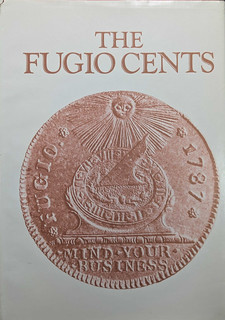 When I originally compiled listings for American Numismatic Biographies, I could not find
information on Alan Kessler, author of The Fugio Cents. Since then, I have gone back several
times looking for information on Kessler. With recent mentions in the E-Sylum, I went back
again this week to check current resources.
When I originally compiled listings for American Numismatic Biographies, I could not find
information on Alan Kessler, author of The Fugio Cents. Since then, I have gone back several
times looking for information on Kessler. With recent mentions in the E-Sylum, I went back
again this week to check current resources.
The book title on the dust jacket, cover and spine is The Fugio Cents. The title page is The Fugio Coppers A Simple Method for Identifying the Varieties with Rarity Listing and Price Guide.
The name of Alan Kessler appears in records for FamilySearch and Findagrave. None of them can be linked to the author. There are 214 citations in the Newman Numismatic Portal. None of these mention his age or provide a middle initial.
2025 ANS TRUSTEES' AWARD TO THE NYINC
Here's the press release on the 2025 American Numismatic Society Trustees' Award. -Editor
On January 16, 2025, the Board of Trustees of the American Numismatic Society (ANS) bestowed the 2025 Trustees' Award to the New York International Numismatic Convention (NYINC) at the Society's Annual Gala, held at the Century Association in New York City. The award recognized the NYINC as one of the most significant conventions in the United States for the numismatic community, having brought collectors, dealers, and enthusiasts of world and ancient coins together for more than fifty years, and its longtime support of the Society's mission.
The Society's Annual Gala welcomed 120 guests to celebrate the NYINC and its partnership with the ANS during the successful evening, which raised more than $217,000. ANS Life Fellow Dr. Arnold-Peter Weiss served as the emcee of the evening, and ANS President David Hendin presented the Trustees' Award.
GERRY FORTIN INTERVIEW, PART FIVE
Greg Bennick's latest interview for the Newman Numismatic Portal is with Liberty Seated dime expert Gerry Fortin. Here's the fifth and final part, where Fortin talks about his decision to sell his collection, his blog, and GFRC Auctions. Be sure to check out Gerry's upcoming auction of his world class Seated dime collection at www.seateddimevarieties.com. -Garrett
GREG BENNICK: Because people wouldn't know that necessarily. So, what was it that made you decide ultimately to sell your collection after working on it for so long?
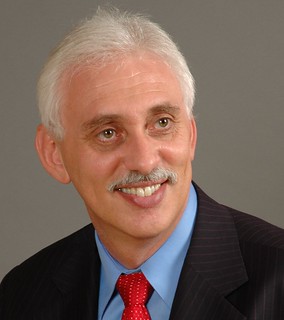 GERRY FORTIN: I tell everybody that the short answer: it was time. Now, what does that mean? Since 2014, I've been selling all my other dimes that were used for the die variety analysis, and I've raised a substantial amount of capital. Well, that capital was going back into my high-end collection. And somehow, I was able, through contacts and through picking spots, I was able to buy some upgrades from the period when Eugene Gardner sold his collection and passed away. So that was 2014. And then we had D.L. Hansen, who kicked in more recently. So, there was a short period in there where I was able to do some more upgrading.
GERRY FORTIN: I tell everybody that the short answer: it was time. Now, what does that mean? Since 2014, I've been selling all my other dimes that were used for the die variety analysis, and I've raised a substantial amount of capital. Well, that capital was going back into my high-end collection. And somehow, I was able, through contacts and through picking spots, I was able to buy some upgrades from the period when Eugene Gardner sold his collection and passed away. So that was 2014. And then we had D.L. Hansen, who kicked in more recently. So, there was a short period in there where I was able to do some more upgrading.
The Tom Bender sale that was held, I think, two years ago, there were some spots in my collection that were weak where I had not allocated monies because they were secondary from an investment perspective. I spent quite a bit of money upgrading that piece of the collection at the Bender sale. And in the past year, essentially, I've liquidated, essentially, all of the dimes through my business. So, my funding source for the collection had dried up.
CNG TRITON XXVIII AUCTION RESULTS
This press release from Classical Numismatic Group discusses results of their recent Triton XXVIII sale. -Editor
An "Ides of March" silver coin struck by Brutus to celebrate the assassination of Julius Caesar sold for an astounding $551,250, and bidding for an extremely rare and beautiful Greek silver coin of the lost city of Pheneos attained a breathtaking $490,000, as strong demand for rare and important ancient, world and British coins drove prices in Classical Numismatic Group's Triton XXVIII Auction, held live in New York City and online January 14-15, to more than double the $5.1 million presale estimate for the 1154- lot offering.
Two follow-up internet sessions, Triton XXVIII Sessions 5 and 6, held January 22-23 in Lancaster PA, also better than doubled their presale estimates to bring the total, bringing the total two-week haul to $12.25 million. All prices quoted include the 22.5% buyer's premium.
ATLAS NUMISMATICS SELECTIONS: FEBRUARY 2, 2025
Atlas Numismatics has updated their website with highlights from our most recent upload of 415 coins, medals, and tokens. Select items are discussed below. -Garrett
1081227 | ROMAN IMPERIAL. Pertinax. (Emperor, January - March 193). Struck 193-194 AD. AV Aureus. NGC Gem MS (Gem Mint State) Strike 5/5 Surface 5/5 Fine Style. Rome. 7.20gm. IMP CAES P HELV PERTIN AVG. Laureate head of Pertinax, right /PROVID - DEOR COS II. Female allegory with right arm raised towards a star, left. Cal.-2389a; RIC-11a; Woodard NC 1957, page 10, 11.
ARCHIVES INTERNATIONAL AUCTION 99 SELECTIONS
Here are some selections from the Archives International sale closing February 5, 2025. -Editor
Lot 113:Ireland, ND (1866-1867). 10 Dollars P-S102r FE7, Remainder Bond, Black on green underprint with portrait of "Wolfe Tone" at lower left and "Davis" at lower right and dramatic eagle on mountain in middle, Back is green, S/N 4276/3276 pp B, PMG graded Choice Uncirculated 64 EPQ, CONB. The Fenian Brotherhood were a committed group of Irish nationalists who attempted an unsuccessful rebellion in the 1860s. Their leaders continued to harass the British for years and help inspire and participate in the eventual successful rebellion against Britain in the early 20th century.
NUMISMATIC AUCTIONS LLC SALE 69
Steve Davis of Numismatic Auctions LLC is holding Sale 69 this month. Here are some selections. -Editor
TAYLOR SWIFT'S ANCIENT COIN NECKLACE
You didn't know The E-Sylum had a fashion department, did you? Well, here's something about Taylor Swift's ancient coin necklace. According to People magazine, "The singer's coin necklace left fans in a spiral of speculation". -Editor
Is Taylor Swift teasing fans with her latest fashion accessory?
For the Kansas City Chiefs game in Missouri on Sunday, Jan. 26, the pop songstress, 35, wore what appeared to be a Steven Battelle-designed 18K gold Ancient Greek coin pendant necklace with a diamond accent, according to fashion pro and Swift expert Sarah Chapelle.
Though fans on X thought the singer might be pointing at her re-recorded album, Reputation (Taylor's Version), with the accessory, believing that the coin had intertwining snakes on it like the one seen for sale here on 1stDibs for $3,100, each of Batelle's necklaces is one of a kind, which means Swift's must be a different piece!
1793 MANCHESTER PROMISSORY HALFPENNY, PART TWO
Denis Richard of Canada's Coin Photography Studio publishes a blog with some nicely researched (and illustrated!) articles on various numismatic topics. With permission, we're republishing one here. Thank you! Here's the second of two parts of an article on the 1793 Manchester Promissory Halfpenny token. -Editor
Manufacturers like William Lutwyche played a pivotal role in the evolution of token production, broadening its driving forces to 'supply' and 'demand.' This transformation turned tokens into a marketed commodity instead of merely a commissioned item.
Lutwyche aimed at the rural market segment, close to the sources of raw materials or waterpower, concentrating his sales efforts on tradesmen and shopkeepers in provincial areas like Manchester. Perhaps a savvy merchant, John Fielding, might have sought out tokens to boost his business visibility or a travelling salesman from Lutwyche's visited his shop. Birmingham's toy manufacturers, even leading medallion creators such as Matthew Boulton, had long employed travelling salesmen to promote their business, and Lutwyche probably followed a comparable strategy, if more modestly.
COLLECTABLE COUNTERFEIT COINS, PART TWO
Here is the second part of Doug Nyholm's article "Collectable Counterfeit Coins", republished with permission from the Utah Numismatic Society's The Mintmaster. Thank you! -Garrett
Another source of counterfeits are those from China. Up until recently one could purchase Dansco albums from China filled completely with fake coins. Usually these were not the highest quality but were passable. Some of these coins have found their way into the market piecemeal and sometimes are consumed by novice collectors. Although these are not truly collectable counterfeits enough of them wind up in unsuspecting hands that many dealers have bins full of them. Similarly the Chinese seemingly counterfeited just about everything from 1795 dated Trade Dollars to Morgan dollars dated 1877-CC.
One other very collectable counterfeit or "restrike" are those created by Daniel Carr in Colorado. Daniel specializes in striking coins on genuine coin planchets (or overstriking on real coins) those issues that might have existed but for some reason never did. By doing this he avoids any legal issues which would result in striking counterfeits. His coins can only be considered as fantasy pieces such as a 1931-S Standing Liberty Quarter, 1964 Franklin Half Dollar and of course the 1964 Peace Dollar. The 1964 Peace Dollar was actually struck in Denver in 1964 but supposedly all were melted and none exist today. This may or may not be true but according to official government documentation none survived.
IRAN CONSIDERING CURRENCY REVALUATION
Howard Berlin passed along this article about Iran's plans to revalue its currency. Thanks. -Editor
Iran launched plans to switch its currency to the toman in 2021, replacing the rial by removing four zeros in a bid to mask inflation. But the plan stalled. Now, the government is hoping to revive the effort.
A loaf of bread in Tehran costs 100,000 rials. Or — should it be 10 tomans now? Or 10,000 tomans (roughly $1)?
For ordinary Iranians, a single toman simply means 10 rials. But with the government attempting to streamline currency, even the basic act of buying groceries could soon become a confusing tangle of numbers.
NORTH KOREAN REVALUATION RUMORED
Meanwhile, North Korean citizens are moving to foreign currencies over the domestic won as revaluation rumors abound. Found via News & Notes from the Society of Paper Money Collectors ( Volume X, Number 32, January 21, 2025). -Editor
Amid persistent rumors of currency redenomination, North Koreans are increasingly shunning the domestic won in favor of foreign currencies. This growing distrust is accelerating the economy's dependence on foreign money.
"Rumors about currency redenomination that began last year continue to spread, and more North Koreans are refusing to hold the domestic currency," a source in South Hamgyong province told Daily NK on Thursday.
CHINESE COMPANY PAYS EMPLOYEES IN SCRIP
In the shades-of-coal-company-scrip department, why bother with real cash if you can pay your employees with scrip good only at your own stores? -Editor
A Chinese company has been placed under official investigation after it gave consumer vouchers instead of money as salary to its employees, triggering online backlash.
A person from northeastern China's Jilin province posted that the shopping centre he worked for, Motian Vitality City, gave its staff consumer vouchers as their salary.
Photos posted by the man on a social media platform showed the vouchers with values ranging from 10 to 500 yuan (US$1.4 to US$70).
LOOSE CHANGE: FEBRUARY 2, 2025
Here are some additional items in the media this week that may be of interest. -Editor
This Greysheet News article discusses the career of commemorative coin innovator Manfred Dunker, who received an award at the World Money Fair 2025 in Berlin. -Editor
Manfred Dunker will forever be known as the foremost innovator of the commemorative coin industry in the 80s, 90s and 00s.
Manfred Dunker was a collector from childhood, collecting stamps and coins. After his time with Dr Oetker, he went on to take charge of the tiny coin unit of Richard Borek, joining in 1985. He had a vision that it could be made into a driving force in coins. He renamed the company to MDM. It did not mean Manfred Dunker Münzenhandel as some suggested, but Münzhandelsgesellschaft Deutsche Münze.
During his time, MDM increased from a small entity to 600 people. Before Manfred joined MDM, commemorative coins were much less common than today. Many European countries issued them only on rare occasions. Manfred Dunker inspired national banks and state mints across the globe to expand their issuance of such coins, both as base metal, silver and gold coins. MDM helped with sales and distribution. Manfred was particularly influential in the development of Olympic coins for events such as Barcelona, Albertville, Lillehammer, Sydney, Torino and Beijing.
To read the complete article, see:
Prize to Manfred Dunker, the Innovator of the Modern Commemorative Coin Market
(https://www.greysheet.com/news/story/prize-to-manfred-dunker-the-innovator-of-the-modern-commemorative-coin-market)
Other topics this week include Internet Archive Workers' Clay Sculptures, and a thieving postal worker. -Editor
FEATURED WEBSITE: THE PAPER MONEY PROJECT
This week's Featured Website is the Paper Money Project. Found via the February 2025 issue of The Mintmaster from the Utah Numismatic Society. -Editor
The Paper Money Project is an attempt to track many early U.S. Small-Size currency varieties and to share the associated census information with the numismatics community. A smaller version of this census project initially started around 20 years ago by Jamie Yakes and focused on $5 LFBP (Late-Finished Back Plate) #637 & #629 Mules, $5 LFP #307 notes, and a few scarce $5 blocks. After the project went dormant for nearly a decade, I picked up where he left off and expanded the census project to focus on a number of other early U.S. Small-Size varieties such as $20 LFBP #204 FRNs, $10 LFP #86 & #87 Silver Certificates, $5 & $10 Narrow Face FRNs, etc.
While this project is starting off as a party of one, my desire is to collaborate with other collectors and numismatists who also find joy and a sense of intrigue in this type of project. I'm open to working with just about anyone who wants to share data, join the project, or help out in other ways. If you'd like to join me on this journey or potentially host a census project on this site, please feel free to reach out to me.
https://www.papermoneyproject.com/
ABOUT THIS ISSUE: FEBRUARY 2, 2025
My E-Sylum work is usually crammed into the weekend, and this week Saturday was particularly unproductive, but that's OK. I was handling chores such as dealing with a security system technician and doing laundry, and pleasant outings such as dinner with family and a stop at the International Bond and Share Society show in nearby Herndon, VA. More on that next week. As always, the issue somehow came together, and many thanks to Garrett Ziss, whose assistance relieves some of the weekly deadline pressure - he handled five of the articles in the issue. -Editor

